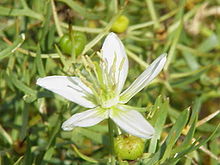Harman alkaloids
The substance group of Harman alkaloids one of the β-carbolines and consists of the substances harmine (7-Methoxyharman), Harman , harmol ( 7-Hydroxyharman ), Harman-3-carboxylic acid, harmaline ( 3,4-Dihydroharmin ) harmalol ( 7-hydroxy-3,4-dihydroharman ) and 1,2,3,4-tetrahydroharmine . The biosynthesis takes place via the amino acid tryptophan , which is converted into a triple ring system with a carbonyl compound. The ubiquitous distribution of tryptophan explains its occurrence in a wide variety of plants, including the steppe rue Peganum harmala , which gives the group its name; but Harman alkaloids have also been found in the liana Banisteriopsis caapi or the nightshade family Vestia foetida . Furthermore, harmanes are formed endogenously in mammals .
In medicine, the Harman alkaloids are used to treat encephalitis and Parkinson's patients. They can also be found in the traditional South American entheogen Ayahuasca (from Banisteriopsis caapi ). Harmaline and harmine in particular have an inhibitory effect on monoamine oxidases ( MAO ) and on ion transport processes ; Among other things, the body can not break down the dimethyltryptamine ( DMT ) contained in ayahuasca , which causes the hallucinogenic effect.
| Melting points of the Harman alkaloids | |||||
|---|---|---|---|---|---|
| substance | Harmine | Harman | Harmaline | Tetrahydroharmine | Harmalol |
| Melting point ( ° C ) | 261 | 237-238 | 232-234 | 187-190 | 212 |
Individual evidence
- ↑ a b Entry on Harmane. In: Römpp Online . Georg Thieme Verlag, accessed on June 13, 2014.
- ↑ a b Wissenschaft-Online-Lexika: Entry on Harman alkaloids in the Lexikon der Biochemie , accessed on April 3, 2009.
- ^ Wissenschaft-Online-Lexika: Entry on Harman alkaloids in the Lexicon of Neuroscience , accessed on April 3, 2009.
- ^ J. Gerardy: Effect of moclobemide on rat brain monoamine oxidase A and B: comparison with harmaline and clorgyline. In: Progress in neuro-psychopharmacology & biological psychiatry. Volume 18, Number 4, July 1994, pp. 793-802, PMID 7938567 .
- ↑ JC Callaway, DJ McKenna, CS Grob, GS Brito, LP Raymon, RE Poland, EN Andrade, EO Andrade, DC Mash: Pharmacokinetics of Hoasca alkaloids in healthy humans. In: Journal of ethnopharmacology. Volume 65, Number 3, June 1999, pp. 243-256, doi: 10.1016 / S0378-8741 (98) 00168-8 , PMID 10404423 .
- ^ The Merck Index . An Encyclopaedia of Chemicals, Drugs and Biologicals . 14th edition, 2006, p. 798, ISBN 978-0-911910-00-1 .
- ↑ Data sheet Harmaline at Sigma-Aldrich , accessed on April 3, 2011 ( PDF ).
- ↑ Alexander Shulgin : TIHKAL # 54, TETRAHYDROHARMINE (English).
- ^ RHF Manske (Ed.): The Alkaloids: Chemistry and Physiology . tape 8 . Academic Press, New York 1965, ISBN 978-0-08-086532-4 , pp. 49 ( limited preview in Google Book search).


